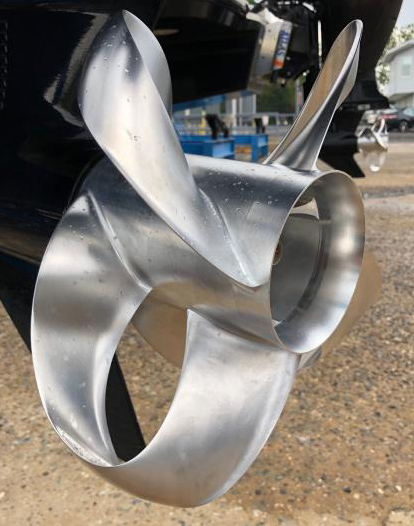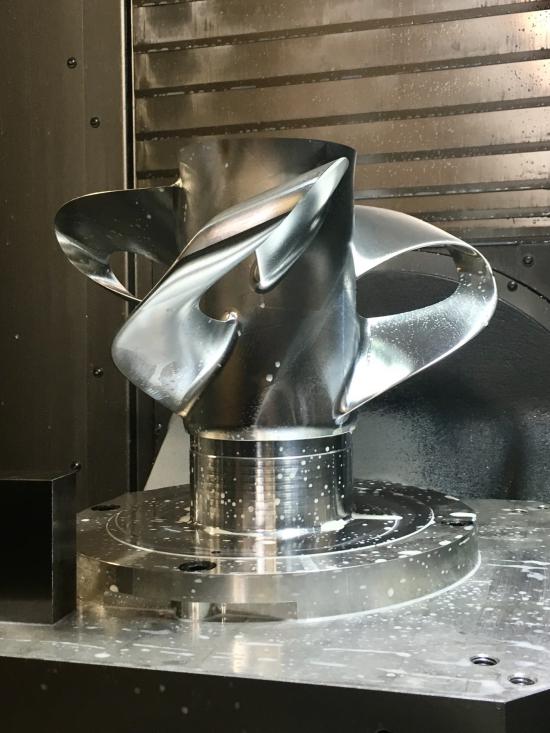Sharrow Propeller receives rave review from BoatTest
Sharrow Propeller is one of many propeller developments we have followed over the years. The loudest ones sometimes turn out to be all hype focused on luring investors into an unproven technology with some big names associated with it. A few have staying power. It sounds like Sharrow Propeller may be the latter.
BoatTest.com a trusted industry source for boat performance test data, published a reviewed the Sharrow propeller in BoatTest’s 14 October 2019 newsletter. As far as technology and performance goes the Sharrow propeller received a rave review.BoatTest.com Review of Sharrow Propeller
BoatTest spent 7 days testing this propeller.
The specific Sharrow propeller tested was called the Sharrow Propeller MX-1 that had been 5-axis router cut from a relatively soft billet of aluminum alloy per BoatTest.
BoatTest tested the Sharrow propeller on a 3500 pound bowrider vs a 14-3/4 inch diameter 15 inch pitch three blade stainless steel propeller they say is an industry favorite. They also tested it against a premium 15 inch diameter 15 inch pitch three blade stainless steel propeller that could plane at lower RPM than the first propeller.
Test crews noted reduced vibration with the Sharrow and easier handling. They noted the boat seems more tightly connected to the water because it basically has six blades grabbing the water.
The Sharrow generally went faster than the other props, reduced slip, improved gas mileage, got on plane faster and at a lower RPM, and had a faster top speed. The test crew was used to some propellers performing better at slower speeds or at higher speeds, but labeled the Sharrows better performance on both ends as “a remarkable result.” The Sharrow also reduced noise and vibrations while improving handling in reverse. BoatTests’ list of 12 positive conclusions is indeed remarkable.
BoatTest noted that Sharrow was actually disadvantaged in the test by them using an aluminum propeller vs the stainless steel propellers they competed against.
BoatTest posted a 14-1/2 minute video of their review on YouTube
Sharrow says they intend to officially debut the propeller at the 2020 Miami Boat Show.
BoatTest went to great lengths to explain how fair and accurately they tried to record data during this review and the considerable efforts they took in doing so. The Sharrow’s results almost sound like a test report dated April Fools Day. But, banking on the proven history of BoatTest we suspect the results are true.
Sharrow is currently using 5-axis cutters to mill away everything that does not look like the propeller out of a large block of aluminum to make prototypes and suggests that may eventually be the mode of manufacture.
BoatTests article shows them using casting patterns cut from 3D printed wax, but their 3D printing capabilities are not at the stage to scale to production volumes.
PropellerSafety comments
We are thrilled to see a new propeller design finally receive rave reviews from a trusted testing source.
We are excited, wish Sharrow Propeller the best, and congratulate them on the performance they have achieved.
While that is wonderful and exciting, we can pretty much guarantee it will not all be clear sailing ahead.
Major obstacles in addition to funding include determining how to manufacture the propeller as economically as possible while maintaining the quality needed. As per the image above, some are currently made by hogging them out of large blocks of aluminum, a very costly method.
In our previous writings about the recreational boat propeller market we have noted the challenges of developing tooling required for manufacturing a wide range of diameter and pitch propellers that are individually targeted for certain types of applications (different rakes, cupped, etc) with 3 or 4 blades. Plus do not forget the need to make them available in both aluminum and stainless steel. Most propeller manufacturers now use a hub with inserts that can be adjusted to the many combinations needed to attach to drives from different manufacturers, sizes, and model years.
Sharrow’s ribbon shaped blades almost look like mobius strips. Pouring aluminum or stainless steel in these shapes and totally avoiding voids and imperfections could be challenging.
Sharrow’s design makes one wonder if one of Mercury Marine’s various lost foam casting methods might work?
Another question is propeller repair. Aluminum propellers are known for their ability to be repaired relatively economically with tooling already in the hands of countless prop shops. Stainless steel props are thinner and tend to be more challenging to properly repair after a substantial impact with a log, rock, concrete boat ramp, etc.
Where will the Shallow fall on that continuum? The ribbon blades look like they might be easily damaged and hard to repair. Meaning propeller life may not be as long as normal aluminum propellers.
Does the Sharrow wind up loose ropes and lines like a normal propeller?
We note Sharrow has their eye on much larger vessels on up to Super Tankers as possible customers benefiting from reduced fuel consumption. If they could be wildly successful on larger vessels their cash flow could fund more investment in recreational vessel propeller development and manufacturing.
Wonder what Sharrow’s goals are? Did they enter this market hoping to be acquired? Do they really plan to develop a facility and all the technologies required to manufacture these propellers in production quantities for all sizes of vessels? Or do they plan on licensing the technology to players in the different propeller markets (recreational vessels, yachts, passenger vessels, larger vessels, huge vessels, military vessels, etc)?
How About Propeller Accidents
The Sharrow Propeller looks vastly different than typical propellers. We have no idea how it performs in terms of possibly showing people out of the area between the blades like the Australian Safety Propeller did OR what its entrapment performance might be, Is it more likely, less likely, or the same to entrap human limbs and appendages, clothing, and/or ropes than a normal propeller?
Is the stronger grip of Sharrow propeller on the water more likely to pull people behind the vessel into the propeller? More likely to pull in those who fell from skis, boards or inflatables when you go back around to pick them up?
Seems like it is time to start running over stuff. Propeller guard manufacturers have long been known for running over all kinds of stuff to test their guards: large squash, cabbage, water melons, dead goats, blown up dolls, wild boars, barrels with hide on them, and many other items. It would be interesting to see the Sharrow propeller runover some of these objects to see how both it and the object look after impact.
It might also be interesting to run the U.S. Coast Guard propeller guard test protocol with an open Sharrow Propeller in comparison to a traditional propeller.
Again we have no concept whether the Sharrow is better, worse, or the same in comparison to normal propellers from a propeller safety standpoint. We just suggest that its performance should be evaluated before it was widely accepted on recreational boats, especially on recreational boat applications known to be more frequently involved in propeller accidents.
Congratulations and Thanks
A big thanks to BoatTest.com for running this test and taking such care to make sure the evaluation was honest, fair, and accurate.
Plus Congratulations again to Sharrow Propeller for having such a tremendous design. We wish them the best in the marketplace.


Hi There,
The mobius ribbon Sharrow Propeller is certainly a major development in marine locomotion. I wonder if it could be adapted to aircraft propellers too. It might be able to be made using carbon/kevlar/resin composite too. This would be good for smaller motors. As I see it the major drawback would be the expense of 4K per wheel. I can buy a whole boat, motor and trailer for that. Now that the concept is out there I am sure that others will try their own verson of it.
I agree. The Sharrow Propeller appears to be a real game changer for certain types of larger boats. It is a real paradigm shift for them, but adoption is going to be slow at the current price tag. As sales go up the price may come down but that is very hard to accomplish during the current inflationary period. It is my understanding the current design is protected by a huge number of patents spread across many countries. However as sales go up the incentives for others to find some way around them grows exponentially. With Yamaha currently being Sharrow’s manufacturing and distribution partner the other major players have to be circling the wagons. We used to call it “Monkey See, Monkey Do” (If a major competitor has some option or feature, our sales people want it too). It will be interesting to see how this comes out. BoatTest.com has certainly been a major player in spreading the word by a believable source. One thing that helps them is the complexity of the design, if they were simple to make everybody under a rock in China would just violate the patents and produce them anyway.
Noticed that the Sharrow owners manual points out that the “edges of the propeller are very sharp” and that the user is required to always “at all times” wear the provided gloves when carrying, handling, or installing the Sharrow “or serious injury may occur.”
That sounds at least as dangerous as a conventional propeller, as one can usually handle those without fear.
One shudders at the idea of what happens when 300hp of spinning loops meet hazards, wildlife, or flesh.
As we mentioned earlier, it seems like the Sharrow is worthy of some propeller safety testing before becoming widely distributed.
However the boat industry has a history of telling the Coast Guard they are unable to change anything without in depth guidance from them regarding proposed regulations they are resisting, but are openly receptive to pretty radical ideas when they are their own.
In defense of the Sharrow, they appear to be targeting larger, heavier boats which spend more time further out from shore (not where swimmers may be) and are not broadly involved with tow boats (not lots of people in the water near their vessels), and their cost plus the cost of larger vessels and larger outboards prohibits most young people from owning them. However, the increasing ease of use of larger vessels is drawing some new people onto the potential customer list without a lot of boating experience.
If they are eventually able to drastically reduce their cost and find a home on smaller boats in large numbers, things could change.
Thank you for your comments.